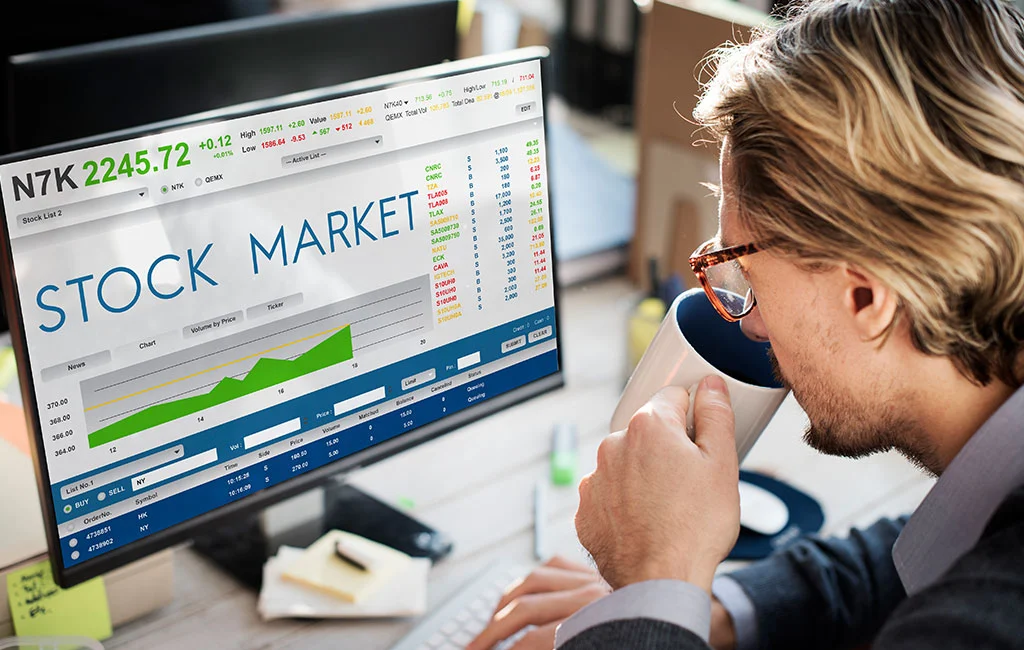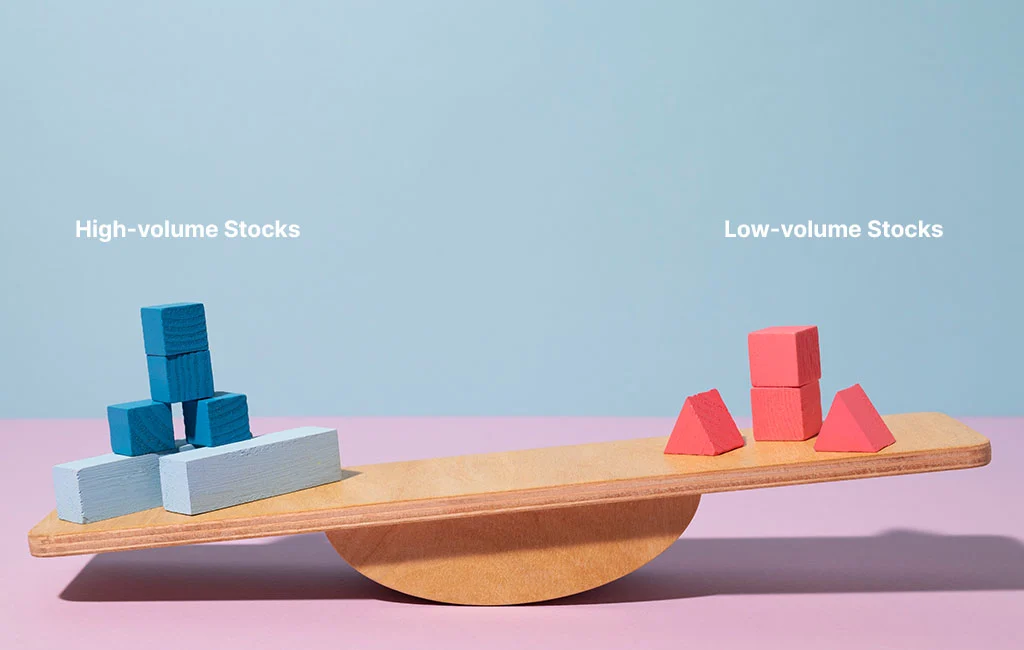According to recent Gallup findings, an impressive 158 million U.S. adults, or 61% of the population, now own stock, marking a 3% increase from 2021. This surge underscores everyday people’s growing interest and involvement in the financial markets, highlighting the importance of financial literacy and the need for clear explanations of complex trading concepts.

The stock market is a complex and vibrant ecosystem where various elements interact to drive. One key concept that often puzzles newcomers and seasoned investors alike is trading volume. But what does volume mean in stocks? It’s fundamental and can provide deep insights into the market’s behavior, influencing decision-making and strategy development. Join us as we delve into the significance of volume in trading, breaking down its implications for investors of all levels.
What Does Volume Mean in Stocks?
In the stock market, “volume” holds significant weight, encapsulating the total count of shares traded within a specific timeframe, most commonly over a single trading day. This concept, often referred to in full as “trading volume,” serves as a vital metric for investors and traders alike, offering a tangible measure of the stock’s liquidity and activity level.
Just as one might monitor the daily sales of coffee at a popular café to gauge its popularity and customer flow, the trading volume of stocks provides a snapshot of how much interest and engagement exist around a particular stock. High volume typically indicates heightened interest from the trading community, whether sparked by recent news, earnings reports, or market trends. This interest drives more transactions and, consequently, more liquidity.
Understanding stock volume goes beyond mere numbers; it involves recognizing the implications of these figures on market behavior and stock performance. For instance, a surge in trading volume can signal a new trend or a shift in stock direction, drawing in investors looking to capitalize on these movements.
Conversely, a drop in trading volume suggests waning interest or stability in the stock’s price, signaling to investors a period of consolidation or the need for caution. Therefore, trading volume is fundamental to navigating the stock market’s ebb and flow. It’s a crucial piece of the puzzle in assessing the market’s sentiment towards a stock, guiding investment decision-making process.
Whether interpreting the significance of a sudden spike in trading volume or understanding the implications of consistently low volume, grasping this concept is essential for anyone looking to engage with the stock market effectively. Just as the number of cups sold can reflect a café’s success and appeal, trading volume in stocks offers a window into the stock’s current standing and future potential in the market landscape.
To figure out a stock’s dollar volume, you just need to do a simple math problem. Take the stock’s price and multiply it by the number of shares usually traded in a day. For example, if a stock is priced at $50 and about 450,000 shares are traded daily, the dollar volume comes to $22.5 million. This tells you how much money is moving with this stock each day.
How Often is Volume Measured?
Volume is measured throughout the trading day, giving investors up-to-the-minute information. This is very important for people who use technical analysis. They look at how stock prices change and use volume—the number of shares traded—to find good times to buy or sell. High volume means a lot of shares are being traded, which can make analysts believe more in a stock’s price movement.
Technical analysts think volume is a big deal because it shows how strong a market move is. If a stock’s price changes significantly and the volume is high, they see this as a strong sign. But if the price changes a lot and the volume is low, they might trust the change less. They use charts to see volume quickly. A bar chart, for example, helps them spot trends. Big bars mean high volume, which analysts think shows strong market interest.
To make smart choices, traders look at volume for clues. For example, to believe a stock price might start going up, they want to see a lot of buying. If they think a stock price will break through a resistance level and keep going up, they look for high volume, too. So, volume is always checked because it helps analysts and traders make better decisions.

High-volume Stocks Vs. Low-volume Stocks
When picking stocks, how often they’re bought and sold—called “volume”—can make a big difference. Here’s what you need to know about high-volume and low-volume stocks:
High-volume Stocks: the Good and Not-so-good
- Less Up and Down: Stocks with lots of trading tend to not jump around in price as much. This means they might be safer because they’re more stable. It’s easier to predict their moves.
- Tight Price Gap: The difference between what buyers want to pay and what sellers want to sell for is smaller. This makes it easier to trade. You’re more likely to buy or sell at prices close to what you expect.
- Easy to Sell: More people trading means you can usually sell your stock quickly if needed. There’s always someone willing to buy or sell, which adds convenience.
- Might Be Risky: Sometimes these stocks are not well-known, like penny stocks. They could be a great find or a big risk. It’s like treasure hunting without a map.
Low-Volume Stocks: Opportunities and Challenges
- Hidden Gems: Stocks not many people are trading might be overlooked. They could be cheap now but grow a lot later. Finding these can feel like discovering a secret.
- Bigger Price Changes: With fewer trades, prices can jump up or down more. This can be risky if the stock’s price moves a lot. It’s a bit like riding a roller coaster.
- Harder to Sell: If not many people are buying, selling your stock quickly might be tough, even if its price has gone up. You may need to wait for the right buyer to come along.
What is a Good Volume for a Stock?
When a stock isn’t bought or sold very much, it can be hard to sell quickly. This is what we mean by “little volume.” Not many people are trading it, so finding someone to buy your shares might take time. Also, big investors or companies can easily change the stock’s price. They do this by buying a lot of shares to increase the price or selling a lot to make it go down. This can make the stock’s price change a lot and quickly.
For a stock to be considered safe and easy to trade, it should be traded a lot. A good rule of thumb is that a stock should be traded at least 400,000 times in 50 days. This is the average daily volume. Also, the total money traded (dollar volume) should be at least $20 million. These numbers help investors feel more confident. They know that the stock is popular and that they can buy or sell it without much trouble.
If the dollar volume is even bigger, like in the hundreds of millions, it’s even safer. With so much money moving in and out of the stock, it’s less likely to drop prices suddenly. This means you’re less likely to lose money if you need to sell your shares quickly. Big dollar volumes mean many people are interested in the stock, making it more stable and reliable for investors.
Harnessing the Power of Trading Volume
Technical analysts make their decisions based on the volume of trades—a count of how many shares are bought and sold. High trading volume indicates a lot of interest in a stock, indicating a strong market move. If there’s a lot of trading when the stock price goes up or down, analysts see this as a good sign. However, they might not trust the price change if not many shares are traded.
Using Volume to Spot Trends
Analysts look at charts that show trading volume to spot these trends quickly. When they see more trading than usual, it suggests something big might be happening with that stock’s price. This helps them decide if a price movement is strong and likely to continue. They use this info to choose the best times to buy or sell stocks.
Volume and Price Changes
Understanding volume helps traders figure out what might happen next with stock prices. For example, if there’s a lot of buying at a stock’s lowest price point, it might mean the price will start to go up. Similarly, if there’s a lot of selling when the price is high, the stock might be about to drop. But the stock’s price might not move much if trading is quiet.
The Impact of High-Frequency Trading on Volume
The landscape of trading volume is evolving with the rise of high-frequency trading (HFT) and algorithmic strategies. These automated systems contribute significantly to the volume, sometimes making up 60% to 80% of daily trading activities. This shift towards automation raises questions about the traditional interpretations of volume. As the market continues to adapt to these technological advancements, the significance of volume in technical analysis may evolve, prompting traders to reconsider how they leverage volume in their strategies amidst an increasingly automated trading environment.
Stocks Volume in the Real World
In real-world trading, volume analysis is used alongside other indicators to assess market sentiment and predict future movements. For instance, volume spikes can indicate the start of new trends, while decreasing volume may suggest that a current trend is losing momentum.

Why Volume is Useful for Investors
Trading volume is a powerful tool for investors aiming to grasp the market’s overall direction. By monitoring changes in trading volume, investors can detect early signs of a market shift.
An increase in volume might indicate rising interest in the stocks, possibly driving prices up or down. Observing how trading volume moves alongside prices gives investors valuable clues about upcoming trends, allowing them to make more informed decisions on buying or selling.
Timing Buy or Sell Decisions
Volume analysis plays a crucial role in timing the market. In scenarios where the market sees falling prices alongside rising volume, savvy investors might see an opportunity to buy lower-priced stocks, anticipating a future recovery and profit from rising prices.
Conversely, an increase in volume coupled with declining prices might prompt investors to sell and cut losses, highlighting volume’s significance in strategizing entry and exit points in the market.
Identifying Market Trends and Breakouts
Trading volume can also illuminate the market’s mood, indicating whether it’s leaning bullish or bearish and signaling potential breakout movements in individual stocks. A stock’s price escalating above a certain threshold on high volume may confirm a breakout, suggesting the stock is set to continue its upward trajectory.
On the flip side, volume can help investors spot false breakouts, where a stock appears poised for a price increase that doesn’t materialize, preventing misinformed investment moves. Through these insights, trading volume becomes an indispensable asset for investors navigating the complexities of the stock market.

Final Words
So, what does volume mean in stocks?
As we wrap up, we’ve learned that trading volume is a big deal in the stock market. Understanding what volume means in stock trading helps us see how active a stock is. If lots of people are buying or selling a stock, it means something is going on, which can help investors make better choices.
If you found this useful and want to learn more about stocks or money, check out our other blogs at EduCounting. We make complex things simple. So, whether you’re just starting out or looking to improve, we’re here to help. Visit EduCounting for more easy-to-understand finance tips.
FAQs
What are the budgeting methods?
There are several budgeting methods, including:
- Zero-based budgeting: Every dollar of income is assigned a specific purpose, such as bills, savings, or discretionary spending so that income minus outgo equals zero.
- 50/30/20 rule: This method suggests allocating 50% of your income for necessities, 30% for discretionary spending, and 20% for savings and debt repayments.
- Envelope system: This involves allocating cash for different spending categories in separate envelopes. Once the cash in an envelope runs out, you stop spending in that category until the next budgeting period.
Values-based budgeting: In this method, you first allocate money to things that align with your core values, then the rest of your budget falls into place around those priorities.
What is the golden rule of budgeting?
The golden rule of budgeting is “Pay Yourself First.” This means before you pay your bills or buy groceries, a portion of your income is set aside for savings (towards an emergency fund, retirement, or specific financial goals).
What is a budget weakness?
A budget weakness refers to flaws or areas of improvement in your budgeting process. This could include consistently overspending, not accounting for all expenses, setting unrealistic budgeting goals, or not regularly reviewing and adjusting the budget.
What is a minimalist budget?
A minimalist budget is a simplified budgeting method that focuses on reducing and simplifying expenses. The goal is to spend money only on necessities and things that truly add value to your life, thereby saving more and reducing financial stress.
What is the 5x spending rule?
The 5x spending rule suggests that you should have at least five times that amount in savings for any discretionary purchase. This rule helps promote mindful spending and prevents impulsive purchases that can disrupt your budget.








